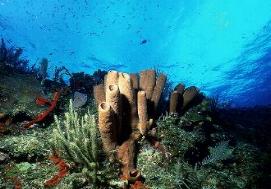Diving experiences of Ruud & Odette

|
Bonaire, Dutch Antilles February 1998 |
| Bonaire, divers paradise. Even the license plates of cars mention it. And they are right. Bonaire is an excellent diving destination, year round. The nearly 60 (!) divesites, mostly on the western part of the island and the nearly 25 sites around Klein Bonaire make it difficult to choose. The book "Bonaire Marine Park" can simplify your choice and gives excellent descriptions of the many divesites, including a recommended route under water. |
| Youíll really need a car here, especially if youíre diving, for all the divesites are "all over the place" and the distances between them and too large to go walking around with your equipment on your back. The dives at Klein Bonaire (an uninhabited island right in front of Kralendijk, the capital) are boat dives, but around Bonaire youíll be shore diving. Most of the time youíll dive unaccompanied. That gives you a lot of freedom: you decide where and when you go diving. The divesites are well marked and visible from the road: a yellow painted stone with the name of the site on it will lead the way. That same name will be found on the yellow marker buoy at sea, always located at the dropoff. The diving is easy: little or no current, a dropoff at 10 to 50 meters (30 to 150 feet) out of the shore line and the reefs are mostly parallel to the shore. Because Bonaire has relatively few sandy beaches and because the bottom is quite rocky at most places, youíre advised to use boots and fins. Your feet will be greatful. |
| There are plenty of divesites worthwhile, so we wonít give you any tips here. But do pay attention to your navigation if you dive from the first to the second reef. A difference of only a few tiny degrees at The Invisibles (site no. 48 in "Bonaire Marine Park") could mean that youíll miss the second reef completely despite the clear waters and that youíll be heading straight for Venezuela (like we did!). If you love wrecks, you shouldnít miss the Hilma Hooker (no. 40). Not a really spectacular wreck, but itís fun, more so because there are barracudas, big tarpons and some huge horse eye jacks holding residence there. Really big fish (apart from the barracudas and tarpons) youíre not likely to encounter. The stern of the ship is at 28 meters (some 90 feet), the bow at 16 meters (50 feet). We were lucky to encounter a big school of pilot whales, with young, and dolphins on a boat trip to Klein Bonaire. The pilot whales occasionally come to rest in the quiet waters between Kralendijk and Klein Bonaire. We went into the water very quietly and snorkeled between them. Very impressive indeed. Too much noise or splashing will only make them disappear, so do try to be quiet if youíre lucky enough to run into them. |
| Bonaire on the surface is great too. Kralendijk, the capital, is a relaxed and cosy little town with plenty of restaurants and bars. There is even some real Dutch food (like "kroket" or "sate") available for those who canít do without. Donít forget to visit National Park Washington Slagbaai and make sure you take your time (youíll need at least two to three hours from start to end, if you shouldnít stop. And be sure to take water or sodas with you). And Lac, with its mangroves, is a place worth visiting. On Sundays it can be very crowded, but on weekdays youíll think yourself on a deserted island. Donít miss Lake Goto, a truely wonderful piece of nature with flamingos. And in Rincon thereís a snackbar "Keeshan Snacks" (a yellow building along the road), where you will have to try the "loempia". |

